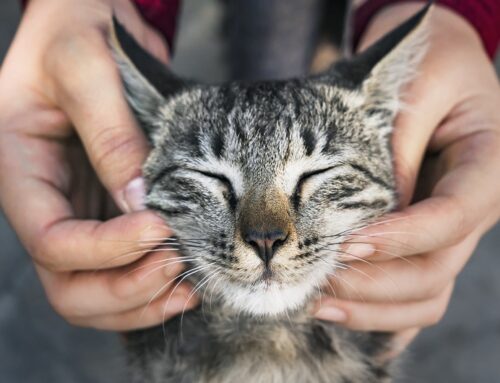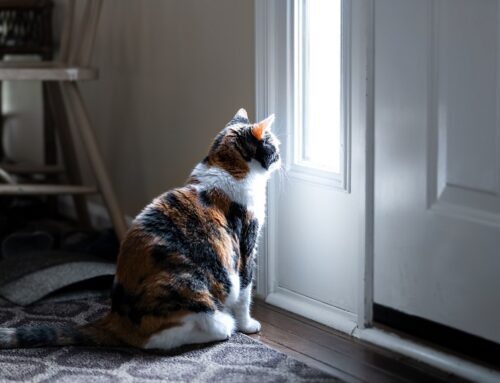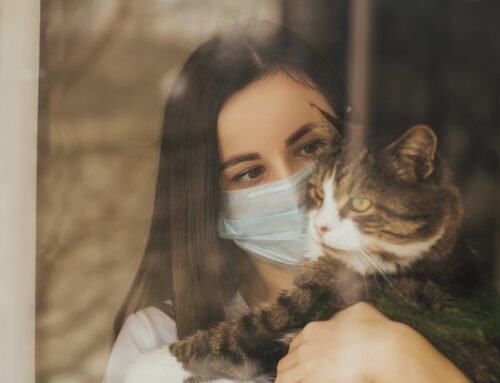Feline Leukemia Virus (FeLV), like FIV discussed last month, is a retrovirus. These viruses insert themselves into the host’s DNA and are one of the main reasons that these infections are difficult to treat and have no cure. Of the two viruses, FeLV is the far more contagious disease. Like FIV, FeLV can be transmitted via direct blood contamination (i.e., cats fighting), but it is far more commonly transmitted through saliva via social interactions such as mutual grooming and sharing bowls. Kittens are exposed to infection by infected queens either directly in utero, through milk when nursing, or by saliva when being groomed. Kittens have immature immune systems and are especially prone to infection. Once a cat’s immune system matures at around 6-8 months of age, there is some natural immunity to FeLV, but adult cats can still become infected.
Detection of FeLV virus in exposed cats can be a bit complicated, as there are several stages of the disease and different tests to detect these different stages. During the first stage, the virus enters the body and circulates in the blood. It takes about one month from exposure for the ELISA , or in-clinic SNAP test, to pick-up FeLV virus in the blood. The SNAP test can only detect FeLV in the blood, which only occurs just after exposure or when it later becomes an active/progressive infection. The second stage of infection is when the virus starts to infect the blood cells (intracellular phase). The main target cell of the leukemia virus is a white blood cell called lymphocytes, and the virus primarily looks for lymphocytes found in the bone marrow. Once the virus becomes intracellular, the ELISA test will no longer detect the virus, and an IFA test is needed. It takes 6-8 weeks from initial infection for the virus to become intracellular. The IFA test does not detect viruses in the blood; therefore, it is possible to have a positive ELISA and negative IFA, if both tests are run early in the disease process. The third stage of the disease is virus replication where the virus becomes a provirus. This phase typically lasts for 3-6 weeks, and cats actively shed viruses and are infectious. Some cats can fight off the virus up to this stage. Stage four is when the provirus integrates itself into the cat’s own DNA; at which point, the cat’s immune system can no longer fight off the virus. A unique–and potentially devastating–aspect of the leukemia virus is its ability to activate oncogenes once it has inserted itself into the cats DNA: this means the leukemia virus can cause cancer in some cats.
Once the virus reaches stage four (insertion into the DNA), the infection can go two ways:
Regressive infection or Progressive infection. Regressive infection occurs more commonly and is where the virus becomes latent. Cats with a regressive infection can remain healthy for many years. Both ELISA and IFA tests will be negative at this stage. However, there is a test called “Real Time PCR” that can detect the provirus (stage three and four). A regressive infection can “reactivate” at any point in time and become a progressive infection. Cats with progressive infections have an active FeLV infection; the DNA provirus becomes active and goes into overdrive, reproducing thousands of copies of itself that travel throughout the body and cause disease. The various disease states that the leukemia virus can cause include tumors, anemia, immune-mediated diseases, reproductive problems, death of kittens, neurological disease, etc. The ELISA test will pick up a progressive infection.
Currently, there is no treatment for FeLV, but there is a vaccine to help prevent infection. All at-risk cats (those that go outside or live with an FeLV positive cat) should be vaccinated annually. FeLV positive cats should not be vaccinated, as the vaccine will not affect the course of a disease already in progress. All new kittens entering a household and sick adult cats should be tested for the leukemia virus. Even adult cats that previously tested negative as a kitten should be retested, if they become ill. This is due to the small window (1-2 months) available to detect infection before it becomes latent and undetectable by common testing means.
We hope you’ve found this information to be very informative! If you have any concerns about the health of your kitty, please do not hesitate to give us a call at (406)728-0022, or visit our website at www.catsonbroadwayhospital.com for more information. Please stay healthy, and enjoy this beautiful autumn! =^_^=








